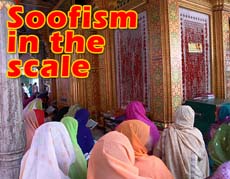Grave worship
It has become a tranquiliser for the Muslim nation, having the same effect on it as opium. The enemies of Islam have realised how important this is for them in enabling them to control and dominate the Muslims; it is because of this that it has played a vital role in their strategies in the past, such as, for example, during the Spanish occupation of Morocco.
During this, the Spanish were faced with a huge uprising due to them building a military post beside the grave of a person whom the masses glorified; therefore, they abandoned the post and subsequently made sure not to provoke people in this regard again.
This caused the people belonging to the sect that venerated the grave to become silent; afterwards, they did not object to anything that the Spaniards did, as long as their tombs were not affected.
Grave worship represents, to those who practice it, a consulting reference on whether or not to fight their enemies. Dr. ‘
Graves represent an alternative national guard for some, who believe that they defend them against the attacks of their human enemies, and even protect them against plague. They believe that every city is protected by a Wali who protects it from evil eyes, attacks, and even natural disasters, as per the saying, for example, Al-Kawthari, who claimed that the area of Shaam (i.e., ancient
Graves are also the last line of defence for these people: The tomb of ‘
Graves are also considered by these people as their supporter and supplier of weapons. During the Arab revolution, followers of this sect spread the rumour that Ahmad ‘Uraabi was gifted three canons by their three most glorified Walis, namely, Ad-Dusooqi, Al-Badawi and ‘Abdul-‘Aal, to use in their fight against the British. Also, when the Russians attacked the city of
Another of them, by the name of Sayd ‘Uways, wrote a book called: “Letters to Imaam Ash-Shaafi’ee.” In one such message, which was dated October 1955 CE, he wrote a request to Imaam Ash-Shaafi’ee ![]() to conduct a meeting and to have present in it Al-Hasan, Al-Husayn, Zaynab, and other members of the household of the Prophet
to conduct a meeting and to have present in it Al-Hasan, Al-Husayn, Zaynab, and other members of the household of the Prophet ![]() may Allah be pleased with them; he requested that they ask Allah, in this meeting, to expel Israel from the sacred land of Jerusalem within a week, and that the deadline for the expulsion be the following Tuesday.
may Allah be pleased with them; he requested that they ask Allah, in this meeting, to expel Israel from the sacred land of Jerusalem within a week, and that the deadline for the expulsion be the following Tuesday.
Graves, for these people, are their source of victory, and they are therefore places of celebration for them: When the French were defeated in Egypt in 1216 AH, Husayn Baashaa Al-Qubtaan, who was the leader of the Ottoman army at the time, rushed to the grave of Al-Husyan, may Allah be pleased with him, and slaughtered five bulls and seven sheep there, which were then distributed among the keepers of the grave.
After this, one asks: Is there anything more tranquilising and harmful to the Muslim nation than such a
belief?
Shirk is what caused the decline and backwardness of the Muslim communities:
Superstition reached its peak when these people categorised graves, grading them according to specific qualities that they assigned to each one. Just as the Greeks and Romans had gods for everything, such as, for example: the god of love, the god of fear, the god of intoxicants, and so on, one finds that these people have given specific qualities to their different tombs; it is due to this that people seek to fulfil particular requests from designated tombs.
A good example to illustrate this fact are the tombs that exist for women, like that of Shaykah Maryam, whose birthday is celebrated twice annually; she is famous amongst people to be the one to ask for being cured of infertility.
In
This was an attempt to clarify some of the evil practices of one of the sects of the Soofees, as well as highlight the wickedness of their beliefs and the dangerous impact that they can have on the Muslim nation.


 Home
Home Discover Islam
Discover Islam Quran Recitations
Quran Recitations Lectures
Lectures
 Fatwa
Fatwa Articles
Articles Fiqh
Fiqh E-Books
E-Books Boys & Girls
Boys & Girls  Hajj Rulings
Hajj Rulings Hajj Fatwas
Hajj Fatwas














